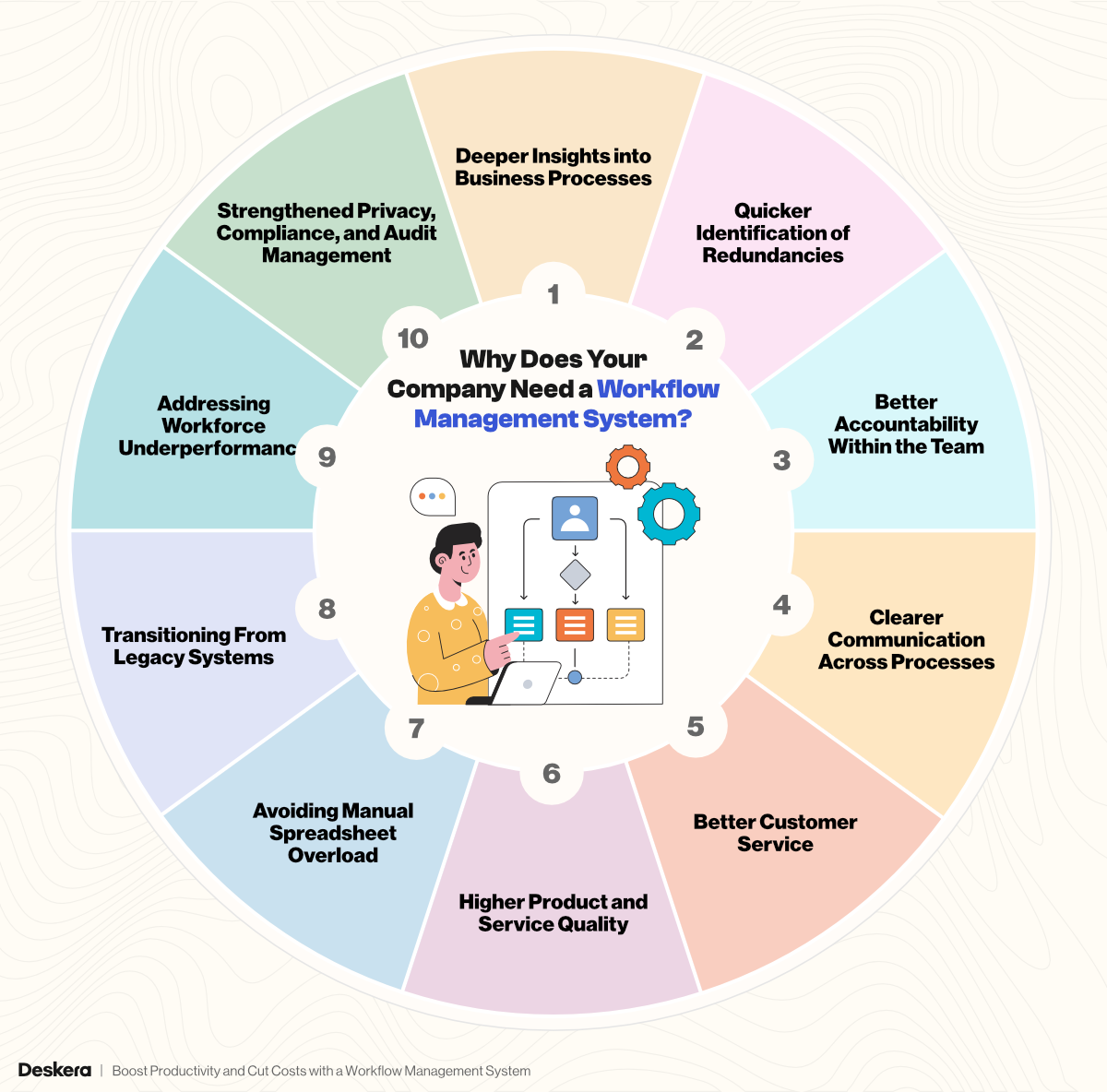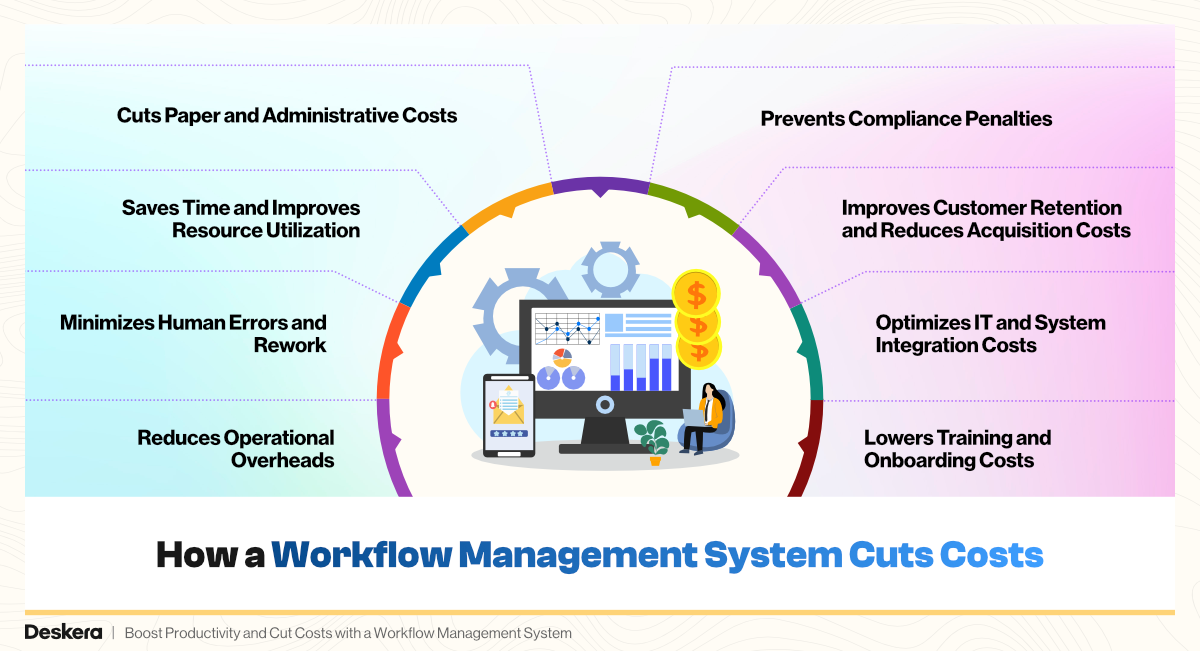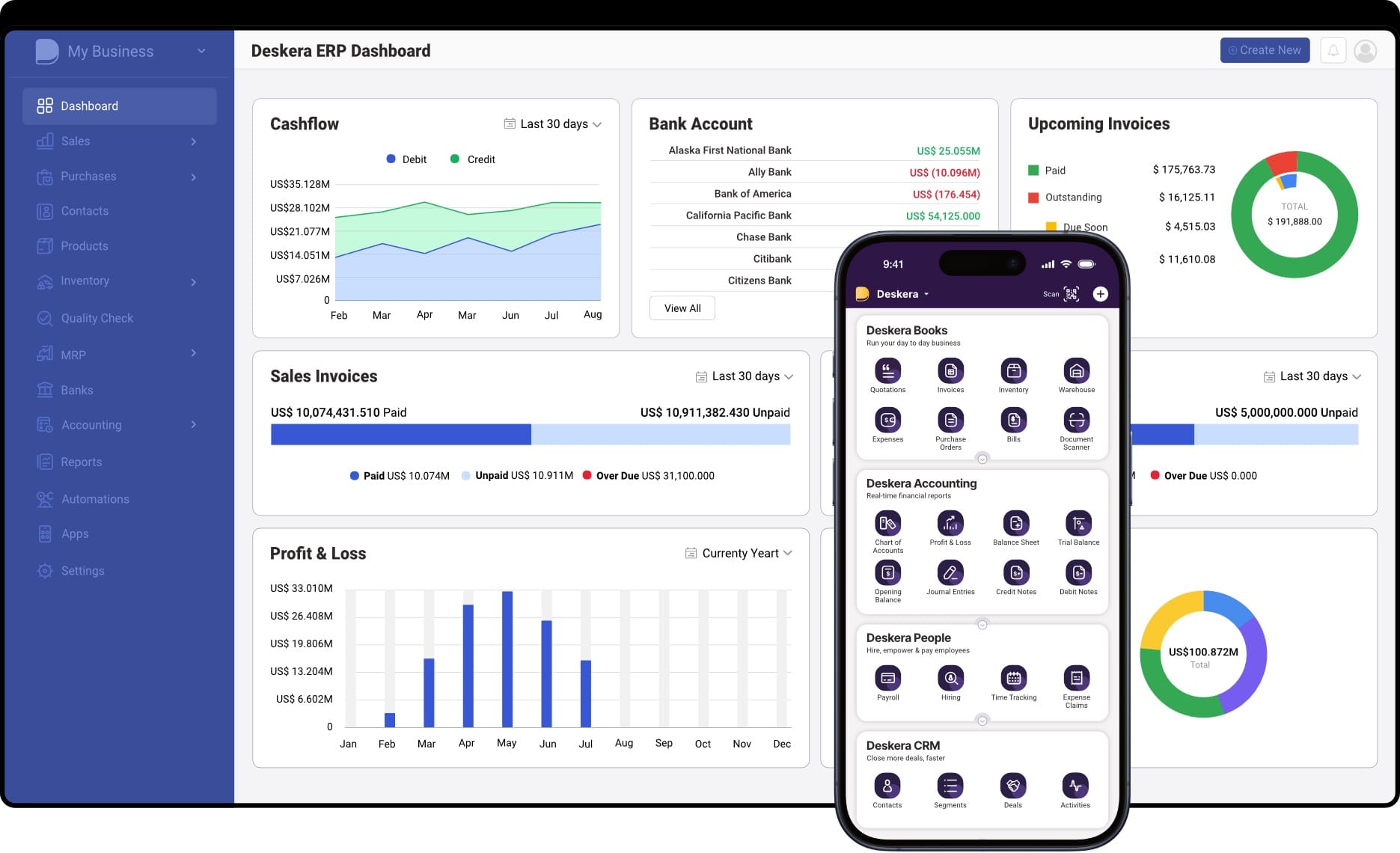In today’s fast-paced business environment, companies are under constant pressure to do more with less—maximizing output while keeping costs under control. Yet, manual processes, communication gaps, and operational inefficiencies often slow teams down and inflate expenses. This is where a workflow management system (WMS) comes in, offering a structured approach to streamline operations, enhance productivity, and cut unnecessary costs.
The growing adoption of workflow solutions reflects this urgent need for efficiency. The global workflow management system market was valued at around $16.95 billion in 2024 and is projected to surge to $168.97 billion by 2032, achieving an impressive CAGR of 33.30%. Similarly, the workflow automation market is on a rapid growth trajectory, expected to expand from $23.77 billion in 2025 to $37.45 billion by 2030. These figures highlight a clear trend: businesses are investing heavily in tools that enable smarter, faster, and more cost-effective operations.
By automating repetitive tasks, improving collaboration, and offering real-time visibility, workflow management systems not only help organizations achieve higher productivity but also directly contribute to significant cost reductions. From small businesses looking to optimize resources to large enterprises aiming to eliminate process redundancies, WMS solutions are becoming an essential driver of operational excellence.
One such solution is Deskera ERP, an all-in-one cloud-based platform designed to help businesses simplify complex workflows. With features like task automation, seamless team collaboration, real-time reporting, and AI-driven insights, Deskera enables organizations to boost efficiency while reducing overhead. Its mobile-first approach also ensures teams stay productive on the go, making it an ideal choice for modern businesses that value agility and cost-effectiveness.
What is a Workflow Management System?
A workflow management system (WMS) is a unified software platform designed to streamline and automate routine business processes for greater efficiency and control. At its core, it integrates several disparate workflow tools into one cohesive application, allowing both human and machine-based tasks to be carried out in a structured sequence according to predefined business rules. This ensures that processes are executed consistently, reducing the risk of delays, bottlenecks, or errors.
One of the defining aspects of a workflow management system is its ability to create digital forms or process templates that capture data and trigger sequential tasks automatically. By following these predefined paths, information moves seamlessly across departments and teams, ensuring tasks are completed in the right order and with minimal manual intervention.
Beyond automation, a WMS also serves as a powerful tool for task management and collaboration. Employees can work within a centralized platform that provides real-time updates, shared dashboards, and integrated communication channels. This not only improves visibility into workflows but also promotes accountability, faster decision-making, and smoother information exchange across the organization.
Ultimately, workflow management systems go beyond just saving time—they unlock productivity gains and strategic value. By reducing manual effort, they free up employees to focus on higher-value work such as problem-solving, innovation, and customer engagement. In today’s competitive landscape, adopting a WMS is not just a matter of operational efficiency—it’s a critical step toward building a more agile, collaborative, and cost-efficient business.
Why Does Your Company Need a Workflow Management System?

A workflow management system (WMS) is no longer a “nice-to-have”—it’s becoming a necessity for businesses aiming to stay competitive, reduce costs, and drive efficiency. Beyond simple task automation, it delivers deeper insights, improves accountability, and enhances customer satisfaction.
Here are some compelling reasons why your company should consider adopting a workflow management system:
1. Deeper Insights into Business Processes
Mapping workflows through a centralized system provides much more than a structured process—it delivers real-time visibility into how each process performs.
These insights help business leaders identify bottlenecks, measure efficiency, and determine whether processes are meeting expectations.
When you have performance analytics at your fingertips, it becomes easier to make data-driven improvements that directly impact the company’s bottom line.
2. Quicker Identification of Redundancies
Manual processes often involve repetitive steps that waste time and resources. A WMS makes these inefficiencies easy to spot and eliminate.
By cutting redundancies, employees can focus on tasks that add strategic value rather than getting stuck in repetitive work. This not only reduces process cycle times but also optimizes resource utilization across the organization.
3. Better Accountability Within the Team
When roles and responsibilities are unclear, accountability suffers and productivity dips. A workflow management system ensures that tasks are clearly mapped to the right people, reducing the need for micromanagement.
Every team member knows exactly what is expected, and progress can be tracked transparently. This clarity fosters ownership, trust, and stronger team morale.
4. Clearer Communication Across Processes
Ineffective communication is one of the biggest barriers to workplace efficiency. A WMS provides a single source of truth, where updates, documents, and task statuses are stored in one centralized hub.
This transparency reduces confusion, streamlines collaboration, and ensures that employees, managers, and stakeholders stay aligned—resulting in smoother day-to-day operations and lower turnover rates.
5. Better Customer Service
Customers today expect speed, accuracy, and seamless service. By automating workflows in areas like support ticketing or complaint resolution, businesses can ensure that customer queries are addressed quickly and efficiently.
Faster cycle times lead to higher satisfaction, improved customer loyalty, and a stronger brand reputation.
6. Higher Product and Service Quality
Consistency and accuracy are critical to delivering quality outputs. A workflow management system helps ensure that processes are followed without deviation, reducing human error and inconsistencies.
Automated checks and streamlined approvals improve the accuracy and reliability of processes, resulting in better-quality products and services delivered on time.
7. Avoiding Manual Spreadsheet Overload
In many organizations, work revolves around spreadsheets and Excel files passed between teams. This not only creates confusion over which version is the latest but also wastes time in approval hierarchies.
A workflow management system automates this process with notifications, version control, and approval tracking, ensuring teams always work on the right file without delays.
8. Transitioning From Legacy Systems
Legacy systems may store documents and files, but they often lack the flexibility, scalability, and integration modern businesses need.
Migrating from outdated platforms to a cloud-based workflow management system ensures secure, reliable data management while offering employees a more intuitive, technology-driven work environment. This transition reduces risks of data loss and enables smoother adoption of modern tools.
9. Addressing Workforce Underperformance
If your workforce feels bogged down by repetitive tasks or clunky processes, they’re not operating at full capacity. A WMS empowers employees by automating routine tasks like leave requests, purchase approvals, or invoice processing.
With approvals streamlined and bottlenecks reduced, staff can focus on strategic, high-value work—leading to improved performance and motivation.
10. Strengthened Privacy, Compliance, and Audit Management
With increasing scrutiny around privacy and compliance, organizations need airtight processes for tracking and auditing. A workflow management system automatically records every change, approval, and transaction, ensuring compliance with regulations while simplifying audits. This not only strengthens data privacy but also minimizes the risk of reputational damage.
Whether it’s eliminating redundant emails, reducing spreadsheet overload, upgrading from legacy systems, or improving compliance, a workflow management system transforms the way businesses operate. It enhances productivity, reduces costs, and ensures teams work at their optimal capacity—all while delivering better outcomes for customers and stakeholders.
Key Features of a Workflow Management System

A modern workflow management system (WMS) is more than just an automation tool—it’s a complete ecosystem that simplifies complex processes, improves decision-making, and enhances collaboration. To truly optimize operations, a WMS should include the following key features:
1. Process Builder (Drag-and-Drop Workflow Design)
A process builder allows businesses to design workflows visually using a drag-and-drop interface. Users can map out each step of a process, define business rules, and decide whether tasks are automated, human-centric, or system-triggered. This feature replaces manual, repetitive steps with automation, enabling organizations to create customized workflows quickly and efficiently without needing technical expertise.
2. Workflow Engine (Rules Engine)
At the heart of a WMS lies the workflow engine—the decision-making hub. It executes tasks based on pre-set rules, such as routing requests to the right employee, sending approval notifications, or calling external systems through APIs. This ensures workflows are consistent, accurate, and scalable, regardless of complexity.
3. Reporting and Analytics Tools
An effective WMS captures data during every step of workflow execution. With real-time dashboards and reporting tools, managers can track task progress, identify bottlenecks, and measure performance metrics.
These insights empower businesses to optimize workflows continuously, reduce inefficiencies, and make smarter, data-driven decisions.
4. Seamless Integration with Third-Party Applications
No workflow exists in isolation. A robust system must integrate smoothly with third-party applications like ERP, CRM, HR, and finance tools using APIs, webhooks, or direct connectors.
This interoperability ensures that workflows run seamlessly across different platforms, eliminating silos and improving collaboration across departments.
5. Dynamic Form Designer
A form designer enables businesses to create customizable forms that gather user input for workflows—such as expense requests, leave applications, or IT support tickets.
With options to add fields, rules, and data types, these forms feed structured data into workflows, ensuring smoother and more accurate process execution.
6. Self-Service Interface
To ensure adoption and ease of use, a workflow management system must include a user-friendly self-service portal. Employees can log requests, track their status, and manage approvals without IT support.
Requests are automatically routed to the relevant teams (HR, Finance, IT, Operations), reducing manual intervention and speeding up response times.
7. AI-Powered Automation
Modern WMS platforms incorporate AI-driven features to enhance efficiency. AI can predict bottlenecks, recommend workflow optimizations, automate repetitive decision-making, and even analyze historical data for future improvements. This level of intelligence ensures workflows evolve with changing business needs.
8. Mobile Accessibility
With today’s distributed workforce, mobile access is essential. A mobile-enabled WMS ensures employees and managers can approve tasks, monitor workflows, and access reports on the go, boosting agility and responsiveness.
9. Role-Based Access and Security
Since workflows often involve sensitive data, a robust system should offer role-based permissions to control who can view, edit, or approve certain workflows. This not only enhances security but also enforces compliance with internal policies and industry regulations.
10. Scalability and Customization
A growing business requires workflows that adapt and scale. The system should allow customizable workflow designs and have the flexibility to handle increasing users, data, and complexity without performance drops.
The best workflow management systems combine automation, integration, analytics, and usability to simplify processes and boost productivity. Whether it’s through drag-and-drop design, AI-powered automation, or seamless integrations, these features ensure workflows align with business goals while reducing costs and inefficiencies.
How a Workflow Management System Boosts Productivity
Productivity challenges often arise from scattered communication, redundant manual work, and unclear accountability. A Workflow Management System (WMS) transforms the way teams operate by introducing automation, structure, and real-time visibility into everyday processes.
Let’s explore how it helps businesses maximize output while reducing wasted time and effort:
1. Streamlines Task Management
A workflow management system provides a centralized platform where all tasks, deadlines, and responsibilities are tracked in one place. Employees no longer need to juggle multiple spreadsheets, email chains, or sticky notes to manage their daily work.
Automated task assignments ensure that no step is forgotten, while reminders and notifications keep everyone aligned with priorities. By eliminating confusion and offering real-time progress tracking, a WMS ensures tasks are completed faster and more efficiently, directly improving team productivity.
2. Reduces Errors and Delays
Human errors, especially in repetitive or manual processes, can lead to costly mistakes and project delays. A WMS reduces these risks by standardizing workflows and automating routine steps based on business rules.
For example, instead of manually routing a purchase request to the wrong manager, the system automatically sends it to the right person for approval.
This not only cuts down rework but also accelerates task completion, ensuring that projects move forward without unnecessary bottlenecks or quality issues.
3. Enhances Team Collaboration
Collaboration often suffers when team members work in silos with fragmented communication tools. A workflow management system breaks these barriers by providing shared dashboards, centralized document repositories, and built-in communication channels.
Team members can view progress, leave comments, and share files directly within the workflow, reducing dependency on back-and-forth emails. This transparency improves coordination across departments and ensures everyone has the same information at their fingertips.
Stronger collaboration leads to fewer misunderstandings, faster execution, and higher productivity levels.
4. Improves Visibility and Accountability
When workflows lack visibility, managers struggle to track progress, and employees are unclear about ownership. A WMS solves this by offering real-time dashboards and reporting features that show the status of every task. Managers can easily identify bottlenecks, reassign tasks, or address inefficiencies before they escalate.
At the same time, employees gain clarity about their individual responsibilities and timelines. This fosters accountability, since each task is traceable, ensuring no one drops the ball and productivity remains consistent across the team.
5. Eliminates Time-Consuming Manual Work
Repetitive tasks such as data entry, document approvals, or sending follow-up emails consume valuable employee time that could be better spent on higher-value work. A workflow management system automates these activities with predefined rules, enabling processes to run seamlessly without constant human intervention.
For instance, an invoice approval process can be fully automated from submission to payment authorization. By reducing manual effort, employees can focus on strategic and creative responsibilities, ultimately increasing organizational productivity and driving long-term business growth.
6. Faster Decision-Making with Real-Time Data
Decision-making can slow down when managers rely on outdated information or spend hours gathering updates. A WMS provides real-time insights into workflows, performance metrics, and task statuses, making it easier for leaders to identify trends and resolve issues quickly.
For example, if a project milestone is at risk, managers can intervene immediately with data-backed decisions. This speed and accuracy in decision-making ensures projects stay on schedule, reduces downtime, and keeps productivity levels high across all business operations.
7. Supports Remote and Mobile Workforce
Today’s work environment demands flexibility, with many employees working remotely or on the go. A workflow management system often includes mobile access, allowing team members to log requests, approve tasks, or monitor workflows anytime, anywhere. This ensures work continuity even across time zones or outside office hours.
For instance, a manager traveling can still approve purchase orders from their phone. By enabling seamless remote collaboration, a WMS eliminates delays and keeps productivity high regardless of physical location.
8. Standardizes Processes for Consistency
Inconsistent processes across departments often lead to inefficiencies and wasted effort. A workflow management system helps businesses define standardized workflows that ensure every task is executed the same way, every time.
Whether it’s onboarding a new employee or processing a customer order, the system applies consistent rules and steps. This reduces confusion, ensures quality, and eliminates duplicated effort.
Standardization not only increases efficiency but also allows teams to scale their operations without compromising productivity or performance quality.
9. Improves Employee Engagement and Motivation
When employees spend less time on repetitive, low-value tasks, they feel more engaged and motivated. A WMS allows them to focus on meaningful work that leverages their skills, such as problem-solving, strategy, or customer engagement.
Additionally, transparency in workflows ensures that contributions are recognized and valued. When employees see the impact of their work and experience less frustration from inefficiencies, morale improves. Higher engagement naturally leads to better collaboration, innovation, and productivity across the organization.
A workflow management system is not just a productivity tool—it’s a catalyst for transforming the way teams operate. By reducing errors, increasing transparency, automating repetitive tasks, and supporting remote collaboration, it empowers businesses to achieve more in less time, with fewer resources.
How a Workflow Management System Cuts Costs

Cost efficiency is one of the strongest benefits of implementing a workflow management system (WMS). By automating tasks, reducing waste, and optimizing resource utilization, businesses can significantly lower operational expenses.
Here’s how a WMS helps organizations save money while maintaining quality and efficiency:
1. Reduces Operational Overheads
A workflow management system eliminates many repetitive, manual tasks such as data entry, email follow-ups, and document routing. By automating these steps, companies reduce the need for excessive administrative staff or overtime hours.
For instance, instead of hiring additional employees to handle invoice processing, a WMS can manage the process end-to-end with minimal supervision. This streamlining of operations directly reduces overhead costs while ensuring that essential tasks are completed quickly and accurately, without additional labor expenses.
2. Minimizes Human Errors and Rework
Errors in manual workflows—like sending contracts to the wrong client or misfiling documents—can be costly in terms of both money and reputation. A WMS ensures accuracy by enforcing standardized processes and business rules.
Automated validations, approvals, and data checks reduce the likelihood of mistakes. By preventing rework, refunds, or compliance penalties, businesses save on unnecessary corrective costs. This not only safeguards revenue but also optimizes the use of resources that would otherwise be wasted on fixing errors.
3. Saves Time and Improves Resource Utilization
Time is money, and wasted time directly impacts profitability. A workflow management system accelerates task completion by automating approvals, sending reminders, and providing real-time visibility into project progress. This efficiency reduces project delays and ensures resources are allocated effectively.
For example, instead of waiting days for a manager’s approval, requests can be automatically escalated or approved instantly based on predefined rules. By saving employee hours, organizations reduce labor costs and get more done with the same workforce.
4. Cuts Paper and Administrative Costs
Traditional workflows often rely heavily on physical paperwork, filing cabinets, and storage space. A WMS digitizes all documents and processes, allowing businesses to move toward a paperless office. This reduces costs associated with printing, stationery, storage, and even courier services.
Additionally, digital documentation makes it easier to retrieve records instantly, saving hours of manual searching. The transition to digital workflows not only lowers administrative costs but also supports sustainability goals, which can enhance brand reputation in the long run.
5. Prevents Compliance Penalties
Regulatory compliance failures can lead to hefty fines and legal costs. A WMS ensures that all workflows adhere to compliance rules by embedding checks, approvals, and audit trails into processes.
For instance, financial workflows can include built-in compliance validations to ensure all transactions meet industry standards. Having a digital record of approvals and activities also simplifies audits, reducing the cost of compliance management.
By proactively preventing regulatory violations, businesses save significant money while safeguarding their reputation.
6. Improves Customer Retention and Reduces Acquisition Costs
Poor customer experience caused by delays, errors, or miscommunication can drive customers away, forcing companies to spend more on new customer acquisition.
A workflow management system ensures smoother, faster, and more accurate service delivery, leading to higher customer satisfaction and loyalty. Retaining an existing customer is far more cost-effective than acquiring a new one.
By reducing churn and building long-term customer relationships, businesses significantly lower marketing and sales expenses while boosting revenue stability.
7. Optimizes IT and System Integration Costs
Many businesses waste money maintaining multiple disconnected software systems that don’t communicate effectively. A WMS reduces these costs by integrating with third-party applications and centralizing workflows on one unified platform.
Instead of paying for several separate tools, companies can manage HR, finance, operations, and IT workflows in one system. This consolidation not only reduces licensing fees and IT maintenance costs but also enhances productivity, ensuring maximum ROI from the company’s technology investments.
8. Lowers Training and Onboarding Costs
Training new employees can be costly and time-consuming, especially when workflows are complex and inconsistent. A WMS simplifies onboarding by standardizing processes and providing user-friendly interfaces with clear task instructions.
Instead of relying on extensive one-on-one training, employees can follow automated workflows and self-service portals to get up to speed quickly. This reduces the cost of training programs, shortens the learning curve, and ensures new hires become productive faster, minimizing the financial impact of turnover.
A workflow management system doesn’t just boost productivity—it directly reduces costs across multiple areas of business operations. From minimizing errors and paperwork to preventing compliance penalties and optimizing resource use, it delivers measurable financial benefits while strengthening efficiency.
How to Successfully Implement a Workflow Management System

Rolling out a workflow management system (WMS) isn’t just about installing software — it’s about aligning people, processes, and technology. To ensure success, businesses must approach implementation strategically.
Here are the key steps to follow:
1. Define Your Goals and Objectives Clearly
Before introducing a WMS, organizations need clarity on what they want to achieve. Is the aim to reduce manual errors, improve cross-team collaboration, speed up approval processes, or cut operational costs?
Setting clear goals ensures that the implementation is guided by measurable outcomes rather than vague expectations. When objectives are defined upfront, the system can be tailored to support those priorities, making adoption smoother and ROI more transparent.
2. Map and Analyze Existing Processes
You can’t improve what you don’t understand. Businesses must begin by mapping current workflows in detail — identifying bottlenecks, redundancies, and pain points. This analysis provides a baseline against which improvements can be measured.
For instance, if an approval process currently takes five days due to unnecessary steps, the WMS can be designed to reduce it to one or two days. Mapping ensures that automation doesn’t replicate inefficiencies but eliminates them.
3. Choose the Right Workflow Management System
Not all WMS platforms are created equal. Companies should evaluate systems based on scalability, integration capabilities, user-friendliness, and support for AI-driven automation. A cloud-based WMS is often preferable as it offers flexibility, real-time access, and lower maintenance costs.
Additionally, businesses should look for solutions that integrate seamlessly with existing tools like CRM, ERP, or HR platforms to avoid data silos and maximize efficiency.
4. Involve Stakeholders and Build Buy-In
Resistance to change is natural, especially when employees are accustomed to manual processes. To address this, involve all stakeholders — from top management to end-users — right from the start.
Collect input, address concerns, and show how the system will make their jobs easier. Transparency builds trust, while early involvement encourages ownership of the change. Without buy-in, even the most advanced WMS can fail due to lack of adoption.
5. Start Small with Pilot Projects
Instead of rolling out the system across the entire organization immediately, begin with a pilot project. Choose a single process — such as expense approvals, leave management, or purchase orders — to automate first.
A pilot allows businesses to test functionality, identify challenges, and gather user feedback before scaling. This phased approach minimizes risk and ensures smoother adoption when the system is expanded organization-wide.
6. Train Teams and Provide Ongoing Support
Training is crucial to ensure users are comfortable with the new system. Interactive workshops, tutorials, and self-service knowledge bases can accelerate learning.
Training shouldn’t just cover how to use the system but also why it’s valuable — highlighting benefits like reduced workload and faster approvals. Beyond initial training, ongoing support and refresher sessions are vital to address questions, encourage adoption, and keep employees engaged.
7. Monitor, Measure, and Optimize Continuously
Implementation doesn’t end with deployment. Businesses should track KPIs such as cycle time reduction, error rates, and cost savings to measure success. Reporting tools within the WMS provide valuable insights into how well workflows are performing.
Use this data to identify areas for improvement and make necessary adjustments. Continuous optimization ensures the system evolves with business needs rather than becoming outdated or underutilized.
8. Ensure Data Security and Compliance
Since workflows often involve sensitive data, it’s essential to configure the WMS with strong security protocols. Role-based access, audit trails, and compliance monitoring must be built into the system.
This ensures that while efficiency improves, security and legal obligations aren’t compromised. Choosing a WMS with robust security features helps protect both the organization and its customers.
Successful implementation of a workflow management system requires a clear vision, stakeholder involvement, smart technology choices, and ongoing optimization. Businesses that treat it as a long-term transformation — rather than a quick tech fix — unlock the real productivity and cost-saving benefits.
Common Implementation Challenges and How to Overcome Them
Implementing a workflow management system (WMS) offers immense benefits, but it’s not without challenges. Many businesses stumble during deployment because they underestimate the cultural, technical, and operational shifts required.
Here are the most common hurdles — and how to overcome them:
1. Resistance to Change
Employees often fear new systems will disrupt their routines or even replace their roles. This resistance can lead to low adoption rates.
Solution: Overcome this by involving employees early in the process, explaining the benefits clearly, and offering hands-on training. When users see how the WMS makes their work easier — by eliminating tedious tasks and freeing up time for strategic work — they are more likely to embrace it.
2. Poorly Defined Goals
Many implementations fail because businesses don’t set clear objectives, leading to confusion and underutilization of the system.
Solution: Establish measurable goals before deployment. For example, aim to reduce approval times by 50% or cut operational costs by 20%. Having defined KPIs not only guides implementation but also makes it easier to measure success and secure leadership buy-in.
3. Lack of Process Standardization
If workflows are chaotic or undocumented, automation will only amplify inefficiencies.
Solution: Standardize processes before automating them. Map existing workflows, identify bottlenecks, and remove redundancies. Only after creating clear, logical workflows should they be migrated into the WMS. This ensures automation drives real improvements rather than digitizing flawed processes.
4. Integration Issues with Existing Tools
A common challenge is integrating the WMS with legacy systems, CRMs, ERPs, or communication platforms. Without smooth integration, data silos persist.
Solution: Choose a WMS that supports APIs, webhooks, and native integrations with popular business tools. Run integration tests during the pilot phase to ensure systems communicate effectively. This reduces disruption and enhances cross-departmental collaboration.
5. Insufficient Training and Support
Even the most advanced WMS will fail if employees don’t know how to use it effectively.
Solution: Provide structured training programs tailored to different user roles. Supplement with self-service resources such as tutorials, FAQs, and user manuals. Also, ensure ongoing support through help desks or dedicated champions who can guide teams after launch. Continuous learning boosts confidence and adoption.
6. Underestimating Data Migration Complexity
Migrating data from legacy systems can be time-consuming and risky, especially when dealing with sensitive files. Errors here can disrupt entire workflows.
Solution: Conduct a thorough audit of existing data before migration. Clean up outdated or duplicate files and back up all critical data. Use phased migration rather than a big-bang approach, and rely on cloud-based WMS platforms with built-in data security and version control.
7. Budget Overruns and Hidden Costs
Without careful planning, businesses may face unexpected costs for integrations, upgrades, or additional licenses.
Solution: Create a realistic budget that covers software costs, training, support, and scalability. Opt for cloud-based subscription models that allow predictable monthly or annual expenses. Regularly review ROI metrics to ensure spending aligns with business outcomes.
8. Neglecting Continuous Optimization
Some companies implement a WMS and then treat it as a one-time project, leading to stagnation and underperformance.
Solution: Treat workflow management as an evolving strategy. Regularly review performance metrics, collect feedback from users, and update workflows to match business growth or regulatory changes. Continuous improvement ensures the WMS remains relevant and delivers long-term value.
The biggest challenges in implementing a workflow management system — from resistance to change to integration hurdles — are manageable with the right strategy. By planning carefully, involving people, and adopting a phased and data-driven approach, businesses can unlock the full power of workflow automation.
How Deskera ERP Helps You with Workflow Management

While understanding the importance of workflow management is crucial, choosing the right tool to execute it is what makes the real difference. Deskera ERP provides a powerful, all-in-one platform that simplifies, automates, and optimizes workflows across departments. From finance and HR to inventory and operations, Deskera helps businesses move away from manual processes and toward smarter, faster, and more transparent workflows. Here’s how:
1. Unified Platform for All Business Functions
Deskera ERP centralizes workflows across accounting, sales, inventory, HR, and manufacturing. Instead of juggling multiple disconnected tools, you get a single system where all processes communicate seamlessly.
This integration reduces silos, eliminates duplicated work, and ensures that everyone has access to real-time data. With all departments aligned, workflows are smoother and far less prone to delays or miscommunication.
2. Built-in Workflow Automation
Deskera automates repetitive, rule-based tasks such as invoice approvals, purchase order processing, payroll, and leave management. Employees no longer waste hours chasing approvals or manually entering data.
Automated notifications, reminders, and escalations ensure that tasks move forward quickly without constant intervention. This not only reduces operational costs but also empowers teams to focus on higher-value, strategic activities.
3. AI-Powered Insights with David, the Virtual Assistant
One of Deskera’s standout features is David, the AI assistant. David helps users track workflows, generate reports, and provide real-time insights into performance bottlenecks. For instance, if an approval is stuck in a queue or a project milestone is delayed, David highlights it instantly.
This visibility allows managers to take corrective action before issues snowball, ensuring smoother workflows and improved accountability across the organization.
4. Customizable Workflow Builder
Every business is unique, and Deskera understands that. The system comes with a customizable workflow builder that allows organizations to design workflows tailored to their processes.
Whether it’s a multi-level purchase approval system, an HR onboarding flow, or a sales pipeline, workflows can be created and adjusted to match specific business needs. This flexibility ensures that automation aligns perfectly with your business rules and policies, without forcing you into rigid, pre-defined structures.
5. Seamless Integration with Third-Party Tools
Deskera ERP integrates effortlessly with popular tools like Shopify, WooCommerce, Stripe, PayPal, and more. This ensures that workflows don’t stop at the ERP but extend across the digital ecosystem your business relies on.
For example, an e-commerce order placed online can trigger automatic inventory updates, invoice creation, and shipping workflows within Deskera, saving hours of manual effort.
6. Advanced Reporting and Analytics
Deskera captures every step of your workflows and translates them into actionable insights. With real-time dashboards and customizable reports, managers can track performance, identify bottlenecks, and measure KPIs like cycle time, cost savings, and resource utilization.
These insights are vital for continuous workflow optimization, enabling businesses to refine processes for maximum efficiency and cost-effectiveness.
7. Mobile Accessibility for On-the-Go Approvals
In today’s remote and hybrid work environments, approvals and workflows can’t be tied to a desk. Deskera’s mobile-friendly ERP ensures managers and employees can approve, track, and manage workflows anytime, anywhere.
Whether it’s approving a purchase order during travel or checking inventory levels on the shop floor, Deskera ensures workflows remain uninterrupted and agile.
Deskera ERP is not just an ERP solution — it’s a complete workflow management powerhouse. By combining automation, AI-driven insights, integration, and flexibility, it enables businesses to streamline operations, reduce costs, and boost productivity.
Key Takeaways
- Workflow management systems are rapidly gaining momentum, with the global market projected to grow from $16.95 billion in 2024 to $168.97 billion by 2032. This explosive growth highlights how essential workflow automation has become for businesses aiming to cut costs and boost efficiency. Deskera ERP stands out as a platform that helps organizations embrace this transformation seamlessly.
- What is a Workflow Management System? A workflow management system is a unified software platform that automates, streamlines, and monitors processes. By reducing manual effort, improving task sequencing, and enabling collaboration, it transforms how organizations handle both human and machine-based workflows.
- Why Does Your Company Need a Workflow Management System? From eliminating redundancies and long email chains to improving accountability, communication, and customer service, a WMS ensures better efficiency and quality. It also helps modernize processes, replace legacy systems, and reduce compliance risks, making it a must-have for businesses aiming to operate at peak performance.
- Key Features of a Workflow Management System: Core features like process builders, workflow engines, reporting tools, third-party integrations, form designers, and self-service portals provide the foundation for smooth automation. Together, these features enhance visibility, reduce bottlenecks, and enable employees to manage workflows more effectively.
- How a Workflow Management System Boosts Productivity: By automating repetitive tasks, enhancing collaboration, improving visibility, and accelerating decision-making, a WMS significantly increases productivity. Employees get to focus on strategic, value-driven work while workflows move forward seamlessly without delays.
- How a Workflow Management System Cuts Costs: A WMS reduces overhead costs, minimizes human error, streamlines resource utilization, prevents compliance penalties, and optimizes IT expenses. It also supports customer retention and lowers onboarding costs, ensuring organizations save money while running more efficiently.
- How to Successfully Implement a Workflow Management System: Clear goal-setting, process mapping, careful system selection, stakeholder involvement, pilot projects, training, continuous monitoring, and robust security measures are key to ensuring a smooth and successful WMS implementation.
- Common Implementation Challenges and How to Overcome Them: Resistance to change, poor goal-setting, integration issues, data migration risks, and lack of training are common hurdles. By involving employees, setting measurable KPIs, standardizing processes, and providing continuous support, businesses can overcome these challenges and unlock the full potential of their WMS.
- How Deskera ERP Helps You with Workflow Management: Deskera ERP provides an all-in-one solution that combines workflow automation, AI-powered insights, customizable workflows, third-party integrations, and mobile accessibility. With advanced reporting and built-in process automation, Deskera helps businesses streamline operations, reduce costs, and achieve higher productivity.
Related Articles

















